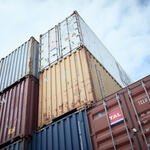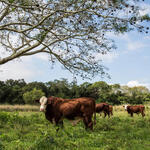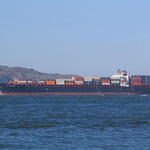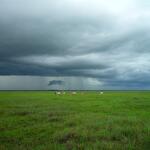- Date: 10 December 2021
- Author: Jason Clay, SVP, Markets & Executive Director, WWF Markets Institute
The elephants in the room these days appear to be credible traceability and transparency. Downstream buyers want to know more and more about where and how their food is produced. To date, this has generally been left to food manufacturers and government agencies to ensure, but in the age of social media and infinite cloud-based information that’s changing.
Companies can no longer set up their own verification programs and expect them to be considered credible. ‘Trust but verify’ is increasingly the norm—and for good reason. The more we find out about global supply chains the less comfortable we are. Most companies are relatively good about knowing their direct suppliers, but it’s clear the trust and expectations can’t be extended further upstream. A piece this week on açaí illustrates the point—companies cannot depend on certification programs to credibly verify conditions of isolated producers. And where there is chatter on social media about problems, companies cannot hide behind systems, they need data. Much can be done to fix this issue, some listed below, but it will be interesting to see what exporters actually do.
To be clear, the goal is not de-commodifying the trade of all food products. That would create chaos. The goal is to maintain the efficiency of the commodity trading system but to add additional data about where and how it was produced. Changing the rules about commodities is not uncommon—the color of #2 “yellow” corn was not officially agreed upon until the late 1960s, and GMO-free commodities are traded to the EU where the market requires that information. So, the system is flexible enough to change and robust enough to incorporate new data.
Still, it’s surprising that systems to eliminate slave, bonded, and child labor, as well as deforestation and other habitat and biodiversity loss and GHG impacts, are so prevalent in supply chains, but apparently are not always working. Traders have said that rules of commodity trading should be left to them, but to date, they have been unwilling or at least unable to address these issues. With regard to labor abuses, we have seen governments (e.g., the US and EU) take much tougher positions for anyone who touches a product produced with illegal labor (with the notable exception of illegal farmworkers in the US). We have not seen the same response for key environmental impacts—though countries are in discussions about deforestation. Perhaps the way to address that is for everyone who touches products with embedded GHG emissions to “own” those emissions until they are mitigated. That would speed up change. Think about it.
…
This post is an excerpt from the WWF Markets Institute's Rethink Food weekly newsletter containing analysis of emerging issues and commentary on recent news stories. Subscribe here.
- Date: 13 July 2021
- Author: Karla Canavan, VP, Commodity Trade and Finance, Katherine Devine, Director of Business Case Development, WWF
Before net-zero commitments became all the rage, companies were pledging to eliminate deforestation from their supply chains. Deforestation and habitat conversion are powerful contributors to climate change, accounting for about 15% or more of global GHG emissions. Despite increasing numbers of commitments and a decade of effort in some cases, companies have struggled to achieve them. It’s not surprising; there are many complex issues in supply chains that could contribute to deforestation and conversion. These range from multiple direct and indirect suppliers, lack of traceability, lack of government support, fluctuating market forces—such as increasing global demand from China, and more. Nevertheless, addressing the challenge of taking deforestation and conversion out of global supply chains (Deforestation- and Conversion-Free, or DCF) can not wait.
- Date: 28 June 2021
- Author: Katherine Devine, Director of Business Case Development, WWF
The COVID-19 pandemic has and will continue to shape the future of food systems for many years to come. The question, though, is how? While many countries and businesses are still in or emerging from survival mode, others have the resources to invest in a food system future with sustainability at its core. The reality is that you cannot separate the two—sustainability will enable survival for companies moving forward. It’s been said that COVID-19 is a dress rehearsal for future disruptions, particularly those related to climate change. Now is the time to prepare for what comes next.
- Date: 27 January 2021
- Author: Katherine Devine, Director of Business Case Development, WWF
The Possibility Is Closer than You Might Think
Many large companies have made environmental commitments to reduce embedded greenhouse gas emissions in the products they make or sell, yet are struggling to reach them. Scope 3 emissions pose a particular set of challenges—all the indirect emissions that occur both up and downstream in a company’s value chain, including from primary production, such as those emitted while producing milk on dairy farms. Within the food industry, supply chains are complex, with many ingredients going into diverse product portfolios. The dairy industry’s Net Zero Initiative¹ (NZI) has established the goal of reaching net zero GHG emissions by 2050 and has set a bold agenda to achieve this goal. Recent analysis conducted by The Markets Institute @ World Wildlife Fund—based on assumptions and data shared by stakeholders in the dairy industry—demonstrates that achieving net zero for large farms is possible with the right practices, incentives, and policies within five years. If businesses also step up to make investments and collaborate with dairy farmers in their supply chain, the potential to reach these goals can become even more tangible.
- Date: 17 December 2020
- Author: Katherine Devine, Director of Business Case Development, WWF
Due to supply chain disruptions as a result of COVID-19, many brands are reducing the diversity of product offerings via stock keeping units, or SKUs. General Mills’ corporate communications manager explained to CNN, "If you think about our Progresso Soup portfolio, we have nearly 90 [varieties], and within those we likely have several varieties of Chicken Noodle. Right now, our consumers and our retailers likely don't need the flavor variations so we're minimizing the variety we are making.” In 2020, consumers anxiously filling their pantries led to stockouts, and it became challenging for brands to forecast available supply of complex product lines. While this reduction in diverse product offerings may mean fewer choices for consumers in the store or online, it can actually be a good thing. The more SKUs a company offers, the harder it is to respond to disruptions. In addition to preventing issues with day-to-day business operations, streamlining SKUs can enable companies to reorient their strategies to meet environmental goals, as well as save them money.
- Date: 20 October 2020
- Author: Kerry Cesareo, Senior Vice President, Forests, World Wildlife Fund
Clearer public-private pathways are putting us on the right track
The end of 2020 marks a crossroads that is both deeply worrying and quite exciting. Deforestation and conversion of natural ecosystems continue unabated, with 3.8 million hectares of tropical primary forest lost in 2019—a 2.8% increase from the previous year. Wildfires rage from the Amazon to the Arctic, and the recent Living Planet Report released by World Wildlife Fund (WWF) shows an average 68% decrease in population sizes of mammals, birds, amphibians, reptiles, and fish in less than 50 years. Deforestation is enabling more human-animal contact and raising the chances of new pandemics spilling over to humans; it also continues to be a primary driver of climate change, creating a vicious cycle.
Concurrently, conservation and restoration of forests, and nature more broadly, have been elevated on the global agenda. Forests are included in the Paris Agreement and in the land-based carbon targets of many countries’ Nationally Determined Contributions. And, building from the experiences of REDD+, governments at the national and subnational level in many key commodity-producing regions are translating these ambitions into action by providing leadership in place-based, multistakeholder efforts to address deforestation and conversion. Increasingly, governments and the business community are engaging with each other. Ghana, for instance, has created action plans with cocoa buyers to address deforestation. In Indonesia, the National Action Plan for Sustainable Palm Oil is providing a structure around which palm oil companies can coordinate their forest protection and restoration efforts in line with government strategies.
Meanwhile, the business case for far more expansive action to protect nature has become obvious. Nature loss is no longer just an issue of reputational risk—it threatens the future of commodity supply and the jobs linked with raw material production. Forest loss is damaging soil quality while changing weather patterns are reducing yields of planted crops. The World Economic Forum’s Global Risks Report 2020 ranked biodiversity loss and ecosystem collapse among the top five threats the global economy will face in the next 10 years.
The private sector has taken notice and begun to evolve its sustainability ambitions to match the scale of the challenge confronting nature. Over the last decade, much of the business community committed to eliminate deforestation from its commodity sourcing, and the Accountability Framework initiative (AFi) and Collaboration for Forests and Agriculture (CFA) have created best-practice guidance to support implementation. More recently, leading companies have begun to align with government and other actors in producing regions on strategies that go beyond individual supply chains to address underlying drivers of nature loss. Several important platforms like the Consumer Goods Forum and Tropical Forest Alliance (TFA) are helping to mainstream expectations that the public and private sectors should collaborate through landscape and jurisdictional initiatives.
This trend is encouraging, but the overall number of companies engaging in these scaled efforts remains low. Major barriers have included uncertainty around the business case for multistakeholder collaboration and a dearth of clear examples to follow. There is also misalignment between the sort of actions civil society is asking companies to undertake and the sustainability practices for which companies are currently recognized and rewarded.
But barriers to engagement are coming down. Over the past year, a group of organizations has developed a suite of new tools and guidance to enable broader company engagement in production geographies where they are invested or exposed. Whereas AFi and CFA provide the key guidance for implementing deforestation/conversion-free commitments within supply chains, these new tools elaborate complementary guidance for addressing systemic drivers. They pull from concrete examples to help companies understand and navigate through their options to engage. And thoughtful collaborations have positioned these tools to be reasonably aligned, thus avoiding the pitfalls of conflicting guidance from civil society.
- A new paper from the United Nations Development Program, Value Beyond Value Chains, clarifies why and broadly how companies can engage in landscape and jurisdictional initiatives. It explains the business case for collaborating beyond value chains at landscape, subnational, and national levels to help create the enabling conditions for sustainable production and provides broad schemas to help companies think about how to engage in multistakeholder initiatives in producer countries.
- A complementary paper from Proforest, Engaging with Landscape Initiatives, fleshes out the how and adds guidance on where to engage. It walks through steps companies should take when thinking about how to engage in landscapes, describing elements of the engagement process like building trust, planning and implementing interventions, and monitoring of progress. And it helps companies understand their supply base, how to prioritize landscapes for engagement, and decide which initiatives they might work with.
- A resource that Walmart recently launched provides more granularity on the question of where to engage, providing maps that show the jurisdictions where companies are likeliest to source key deforestation-risk commodities and the deforestation risk of these jurisdictions.
- Building on these tools, TFA released a set of corporate guidance and a dynamic web-based tool developed by WWF and Proforest that goes the next step in describing what specific actions companies can implement to advance landscape and jurisdictional initiatives. It provides concrete interventions companies can take, offers real-world examples where companies are already doing so, and proposes guidance on how to execute.
- Each of the previous tools informs corporate action. New guidance from ISEAL Alliance on Verification of Jurisdictional Claims lays out the parameters for assuring progress at the landscape/jurisdictional scale and for making credible claims about contributions toward that progress. It walks through practical steps to ensure the integrity of landscape-level performance data and how progress is communicated, and it explores the types of claims companies can make depending on the ways they engage.
While time is running out to reverse global ecosystem loss, we’re finally at a point where governments and companies are beginning to mobilize at the scale required to meet our conservation imperatives. Thanks to this new guidance, the pathways for corporate action are clearer than ever. Now, with these tools in hand, the moment has come for public-private partners to accelerate their joint efforts—for the future of the natural world and generations to come.
- Date: 22 June 2020
- Author: Jason Clay, SVP, Markets
Finding the right balance between food imports and domestic production will continue to be a challenge as COVID-19 disrupts supply chains and governments want to ensure that food will be available for their citizens. Trade is an essential part of any sustainable food system. There will be pandemics, droughts, and plagues of locusts in any given year, and unfortunately, like now, sometimes all in the same year. Trade helps the global food system fill in the cracks created by disruptive individual or multiple events, regardless of their origin, that may lead to localized rolling hunger across a landscape.
- Date: 16 June 2020
- Author: Corey Norton, VP, Supply Chain Legality, Jason Clay, SVP, Markets
One of the less-publicized COVID-related threats to the environment is the inadequate response to reports that almost 200,000 crew on cargo shipping vessels cannot go home despite completing their voyage. These cargo vessel crew are stuck onboard and cannot be relieved by a new crew due to widespread travel restrictions. Almost all world trade is shipped via these vessels, which when operating with fatigued crew increasingly risk collisions and other accidents, which can cause fuel spills, cargo lost overboard, and other significant harm to oceans and surrounding environments.
- Date: 19 February 2020
- Author: David Schorr, Senior Manager, Transparent Seas, WWF
Changing any complex system requires finding a point of maximum leverage. When it comes to creating transparency in the seafood trade, access to reliable information is the key, and there are two points of leverage to make it happen: getting companies around the world to agree on what data is needed, and ensuring they can share it seamlessly .
Affordable and reliable traceability—the concept of tracking seafood from bait to plate—depends on fishers and aquaculture farmers routinely providing verifiable data. One way to achieve that vision is for governments to require this information as a routine part of access to markets. But currently there is no global agreement on what information must accompany seafood products. In fact, a new study from a consortium of NGOs analyzed the key data elements required in the top three seafood markets—US, EU and Japan—which are responsible for nearly two thirds of all seafood imports. It found that even governments with the most robust import regulations don’t fully capture all of the data needed to ensure that the fish bought by consumers is coming from legal sources.
That’s where the considerable leverage of market leaders in industry comes in. WWF has been working with seafood companies around the world to develop urgently needed standards for capturing and sharing a consistent set of basic information based on shared industry-wide expectations.
Seafood is one of the most globalized of all food commodities, with supply chains that crisscross oceans and continents. While this global web of production allows coastal communities to sell their seafood products into important international markets--and gives consumers access to seafood from every corner of the planet--there are risks and new responsibilities for businesses. Traceability systems can mitigate these risks and provide benefits to public health, social welfare, and environmental sustainability. But only if those systems can communicate seamlessly via globally established standards. Businesses have a stake in enabling that to happen.
The first step is for companies to agree on what information needs to be shared. Key Data Elements, known as KDEs, are imperative for establishing reporting requirements at critical stages of production and trade. These can work hand-in-hand with government reporting requirements and trade controls, as well as with systems for data collection needed for sustainable resource management. Having the right KDEs is also what generates value in the form of consumer and brand confidence.
In fact, getting industry-wide agreement on KDEs is one key part of a new set of industry-led standards that are about to start reshaping the way businesses do seafood traceability. As highlighted in an open letter recently released by a group of seafood industry leaders, these groundbreaking standards include a ‘basic universal list’ of standardized seafood KDE’s that will set a global baseline for the information that should accompany all seafood products. These new standards, about to be released at a major seafood industry trade show in Boston this March, have been developed by industry through the Global Dialogue on Seafood Traceability, or GDST for short. The GDST 1.0 standards are the data-sharing foundation on which reliable, affordable, and efficient seafood traceability will be built.
Not only does GDST 1.0 provide a universal check-list of the information that must accompany seafood products, it sets out technical specifications for how systems share that information seamlessly. These technical standards are already being road tested by leading seafood supply chain companies, including some of the world’s biggest seafood processors, brand owners, and retailers. For the companies involved, it’s not just a matter of meeting CSR goals – these system design standards are helping address core business functions, and ensuring better return on investment when companies upgrade their traceability systems.
The ocean provides a bounty of seafood, supporting hundreds of millions of jobs and feeding billions of people. Creating seafood supply chain transparency creates accountability and provides the data needed for improved science-based management of fisheries and aquaculture farms. This mix of sustainability and business strategy is a powerful lever for driving change in the complex world of seafood trade and when GDST 1.0 launches this March during the North American Seafood Expo, industry will be one step closer to sustaining the future of the seafood industry.
- Date: 09 January 2020
- Author: Jason Clay
The Markets Institute at WWF identifies global issues and emerging trends around the most pressing challenges of our time to help us all learn and shift faster. As always, we'll be tracking a wide variety of food and soft commodity issues, trends, and tools as we move into 2020, dubbed the super-year for the environment. We know we will see more political volatility and financial crises, and the impacts of climate change to not only be felt more deeply but also recognized for what they are—a ticking time bomb for the future so long as they are not addressed. Here are just a few of the other issues, trends and tools we will be tracking this year:









